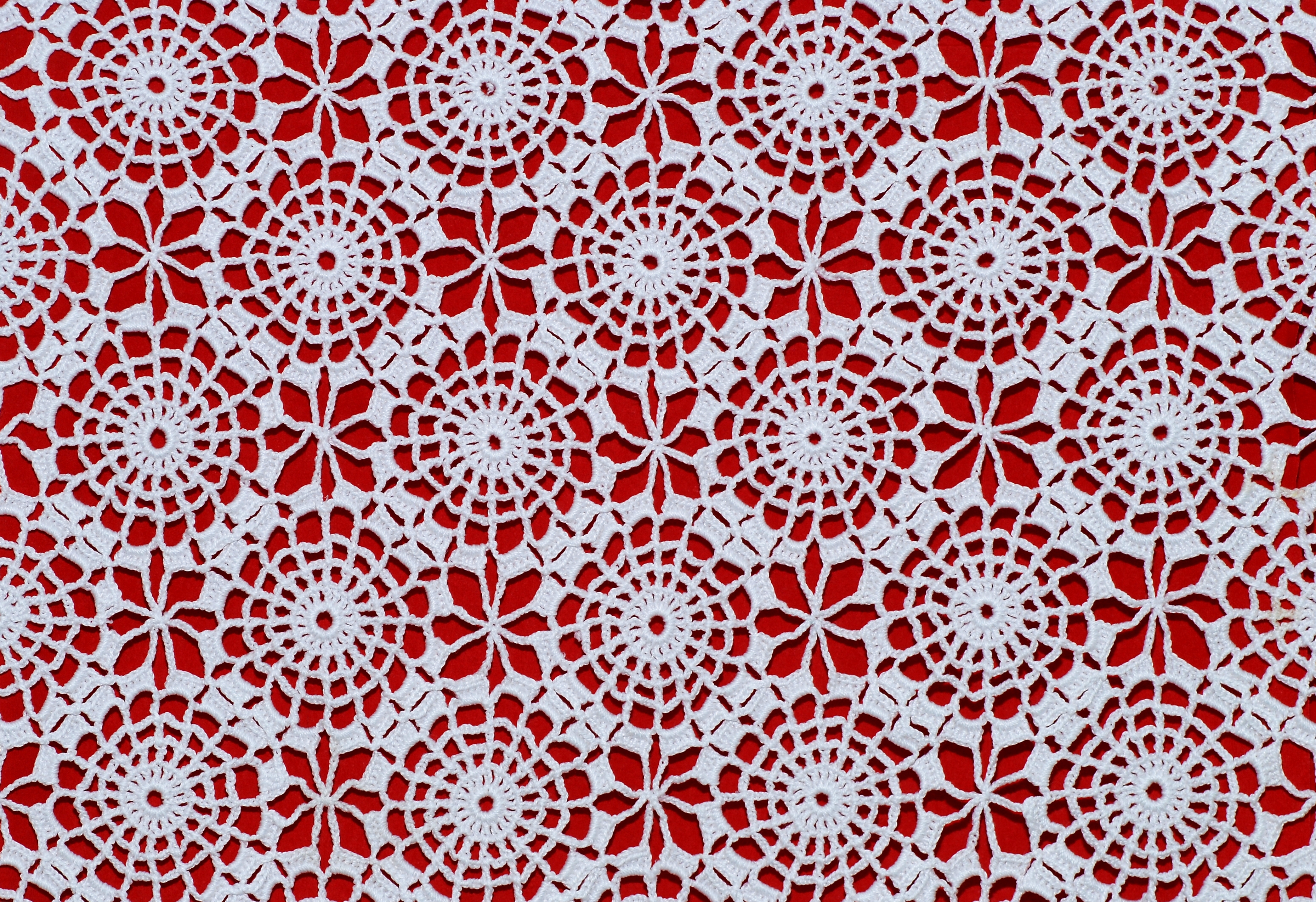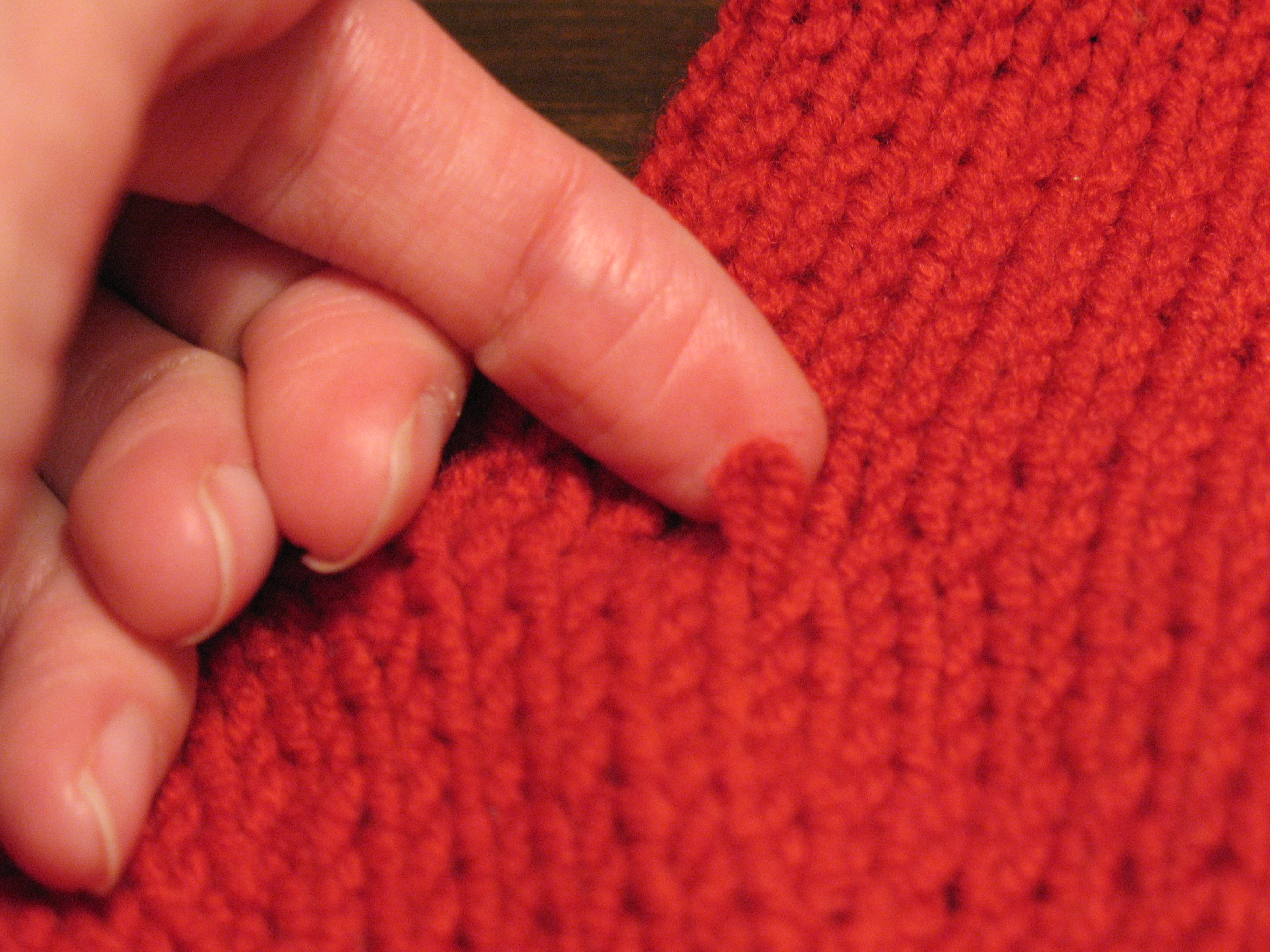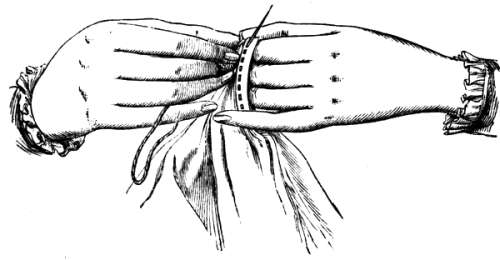|
Hook Gauge
A hook gauge or ''needle gauge'' is a measuring device used by crocheters and knitters to test the sizes of particular crochet hooks and knitting needles. Hook gauges are usually made of plastic or aluminum and have sizing holes from 2mm to 11mm diameter. A hook gauge also functions as a ruler to test the size of a test swatch of handmade fabric.Stoller, p. 23. Sizing conventions A hook gauge is the most reliable way to determine the actual size of a tool. Even though most hooks and needles have metric sizing, tool dimensions vary slightly between different manufacturers. Non-metric sizing conventions also change over time. For instance, different sizing charts rate a 4.0mm hook as either a U.S. G/6 or an F/5. Importance of accurate sizing U.S. textile craft terminology employs the word ''gauge'' in two different ways: as ''hook gauge'' in reference to the sizing tool, or as a standalone term gauge to describe the number of stitches in a standard sized sample of work, ... [...More Info...] [...Related Items...] OR: [Wikipedia] [Google] [Baidu] |
Crochet
Crochet (; ) is a process of creating textiles by using a crochet hook to interlock loops of yarn, thread (yarn), thread, or strands of other materials. The name is derived from the French term ''crochet'', which means 'hook'. Hooks can be made from different materials (aluminum, steel, metal, wood, bamboo, bone, etc.), sizes, and types (in-line, tapered, ergonomic, etc.). The key difference between crochet and knitting, beyond the implements used for their production, is that each stitch in crochet is completed before the next one, while knitting keeps many stitches open at a time. Some variant forms of crochet, such as Tunisian crochet and Broomstick lace, do keep multiple crochet stitches open at a time. Etymology The word crochet is derived from the French language, French word , a diminutive of ''croche'', in turn from the Germanic languages, Germanic ''croc'', both meaning "hook". It was used in 17th-century French lace-making, where the term ''Crochetage'' designated a sti ... [...More Info...] [...Related Items...] OR: [Wikipedia] [Google] [Baidu] |
Knit
Knitting is a method for production of textile fabrics by interlacing yarn loops with loops of the same or other yarns. It is used to create many types of garments. Knitting may be done by hand or by machine. Knitting creates stitches: loops of yarn in a row; they can be either on straight flat needles or in ''the round'' on needles with (often times plastic) tubes connected to both ends of the needles. There are usually many ''active stitches'' on the knitting needle at one time. Knitted fabric consists of a number of consecutive rows of connected loops that intermesh with the next and previous rows. As each row is formed, each newly created loop is pulled through one or more loops from the prior row and placed on the ''gaining needle so'' that the loops from the prior row can be pulled off the other needle without unraveling. Differences in yarn (varying in fibre type, ''weight'', uniformity and ''twist''), needle size, and stitch type allow for a variety of knitt ... [...More Info...] [...Related Items...] OR: [Wikipedia] [Google] [Baidu] |
Crochet Hook
A crochet hook (or crochet needle) is an implement used to make loops in thread or yarn and to interlock them into crochet stitches. It is a round shaft pointed on one end, with a lateral groove behind it. The point eases the insertion of the hook through the material being crocheted and the groove makes it possible to pull a loop back through the material. The shaft is then divided into a working area that determines the hook's nominal diameter and ensures the uniform sizing of the loops formed on it, and a handle. Construction Crochet appeared as a distinct textile arts, textile art during the early 19th century, and many crochet hooks survive from that period. These can be sorted into two groups, the one with thin steel hooks that are set into separate handles, and the other including single-piece hooks made in a variety of materials. The distinction between steel and other hooks persists to the present day, although all are now commonly of single-piece construction. A variety ... [...More Info...] [...Related Items...] OR: [Wikipedia] [Google] [Baidu] |
Knitting Needle
A knitting needle or knitting pin is a tool in hand-knitting to produce knitted fabrics. They generally have a long shaft and taper at their end, but they are not nearly as sharp as sewing needles. Their purpose is two-fold. The long shaft ''holds'' the active (unsecured) stitches of the fabric, to prevent them from unravelling, whereas the tapered ends are used to ''form new stitches''. Most commonly, a new stitch is formed by inserting the tapered end through an active stitch, catching a loop (also called a Bight (knot), bight) of fresh yarn and drawing it through the stitch; this secures the initial stitch and forms a new active stitch in its place. In specialized forms of knitting the needle may be passed between active stitches being held on another needle, or indeed between/through inactive stitches that have been knit previously. The size of a needle is described first by its diameter and secondly by its length. The size of the new stitch is determined in large part b ... [...More Info...] [...Related Items...] OR: [Wikipedia] [Google] [Baidu] |
Fabric
Textile is an umbrella term that includes various fiber-based materials, including fibers, yarns, filaments, threads, and different types of fabric. At first, the word "textiles" only referred to woven fabrics. However, weaving is not the only manufacturing method, and many other methods were later developed to form textile structures based on their intended use. Knitting and non-woven are other popular types of fabric manufacturing. In the contemporary world, textiles satisfy the material needs for versatile applications, from simple daily clothing to bulletproof jackets, spacesuits, and doctor's gowns. Textiles are divided into two groups: consumer textiles for domestic purposes and technical textiles. In consumer textiles, aesthetics and comfort are the most important factors, while in technical textiles, functional properties are the priority. The durability of textiles is an important property, with common cotton or blend garments (such as t-shirts) able to ... [...More Info...] [...Related Items...] OR: [Wikipedia] [Google] [Baidu] |
Metric System
The metric system is a system of measurement that standardization, standardizes a set of base units and a nomenclature for describing relatively large and small quantities via decimal-based multiplicative unit prefixes. Though the rules governing the metric system have changed over time, the modern definition, the International System of Units (SI), defines the metric prefixes and seven base units: metre (m), kilogram (kg), second (s), ampere (A), kelvin (K), Mole (unit), mole (mol), and candela (cd). An SI derived unit is a named combination of base units such as hertz (cycles per second), Newton (unit), newton (kg⋅m/s2), and tesla (unit), tesla (1 kg⋅s−2⋅A−1) and in the case of Celsius a shifted scale from Kelvin. Certain units have been Non-SI units mentioned in the SI#Units officially accepted for use with the SI, officially accepted for use with the SI. Some of these are decimalised, like the litre and electronvolt, and are considered "metric". Others, like ... [...More Info...] [...Related Items...] OR: [Wikipedia] [Google] [Baidu] |
United States
The United States of America (USA), also known as the United States (U.S.) or America, is a country primarily located in North America. It is a federal republic of 50 U.S. state, states and a federal capital district, Washington, D.C. The 48 contiguous states border Canada to the north and Mexico to the south, with the semi-exclave of Alaska in the northwest and the archipelago of Hawaii in the Pacific Ocean. The United States asserts sovereignty over five Territories of the United States, major island territories and United States Minor Outlying Islands, various uninhabited islands in Oceania and the Caribbean. It is a megadiverse country, with the world's List of countries and dependencies by area, third-largest land area and List of countries and dependencies by population, third-largest population, exceeding 340 million. Its three Metropolitan statistical areas by population, largest metropolitan areas are New York metropolitan area, New York, Greater Los Angeles, Los Angel ... [...More Info...] [...Related Items...] OR: [Wikipedia] [Google] [Baidu] |
Textile Arts
Textile arts are arts and crafts that use fiber crop, plant, Animal fiber, animal, or synthetic fibers to construct practical or decorative Physical object, objects. Textiles have been a fundamental part of human life since the beginning of civilization. The methods and materials used to make them have expanded enormously, while the functions of textiles have remained the same, there are many functions for textiles. Whether it be clothing or something decorative for the house/shelter. The history of textile arts is also the history of international trade. Tyrian purple dye was an important trade good in the ancient Mediterranean. The Silk Road brought China, Chinese silk to India, Africa, and Europe, and, conversely, Sogdian art#Textile arts, Sogdian silk to China. Tastes for imported luxury fabrics led to sumptuary laws during the Middle Ages and Renaissance. The Industrial Revolution was shaped largely by innovation in textiles technology: the cotton gin, the spinning jenn ... [...More Info...] [...Related Items...] OR: [Wikipedia] [Google] [Baidu] |
Gauge (knitting)
The term "gauge" is used in knitting to describe the fineness size of knitting machines. It is used in both hand knitting and machine knitting. The phrase in both instances refers to the number of stitches per inch rather than the size of the finished article of clothing. The gauge is calculated by counting the stitches (for hand knitting) or needles (on a knitting machine bed) across a number of inches, then dividing by the sample's width in inches. Gauge on knitting machines There are two types of classification of Knitting Gauges or Unit of Measure: *A – Used for Cotton Fully fashion flat machines (Bentley – Monk, Textima, Sheller, etc.) where "Gauge" is measured in 1.5 inches (2.54 cm). The machine's gauge is expressed by the number of needles needed to achieve that gauge. *B – Used for hand, mechanical, or modern Electronic Flat Machines (Stoll, Shima, Protti, etc.), where gauge is measured in 1-inch (2.5 cm) increments. The machine's gauge is again measured ... [...More Info...] [...Related Items...] OR: [Wikipedia] [Google] [Baidu] |
Stitch (textile Arts)
In the textile arts, a stitch is a single turn or loop of thread, or yarn. Stitches are the fundamental elements of sewing, knitting, embroidery, crochet, and needle lace-making, whether by hand or machine.Picken (1957), p. 322 A variety of stitches, each with one or more names, are used for specific purposes. Sewing, embroidery, and lace Examples include: * Backstitch * Overcast stitch * Cross stitch * Buttonhole or blanket stitch * Chain stitch * Knot stitch These stitches and their variations are named according to the position of the needle and direction of sewing (''running stitch'', ''backstitch''), the form or shape of the stitch (''chain stitch'', '' feather stitch'') or the purpose of the stitch ( tailor's tack, ''hem stitch'').''Reader's Digest'' (1976), pp. 122–143 Sewing machine stitches are classified by their structure: *Chain stitch, made with one thread * Lockstitch, made with two threads *Overlock, made with one to five threads * Coverstitch, made ... [...More Info...] [...Related Items...] OR: [Wikipedia] [Google] [Baidu] |
Yarn
Yarn is a long continuous length of interlocked fibres, used in sewing, crocheting, knitting, weaving, embroidery, ropemaking, and the production of textiles. '' Thread'' is a type of yarn intended for sewing by hand or machine. Modern manufactured sewing threads may be finished with wax or other lubricants to withstand the stresses involved in sewing. Embroidery threads are yarns specifically designed for needlework. Yarn can be made of a number of natural or synthetic materials, and comes in a variety of colors and thicknesses (referred to as "weights"). Although yarn may be dyed different colours, most yarns are solid coloured with a uniform hue. Etymology The word " yarn" comes from Middle English, from the Old English , akin to Old High German ', "yarn", Dutch ', Ancient Greek (''chordē'', "string"), and Sanskrit , "band". It originally referred to entrails. History The human production of yarn is known to have existed since the Stone Age and earlier p ... [...More Info...] [...Related Items...] OR: [Wikipedia] [Google] [Baidu] |







